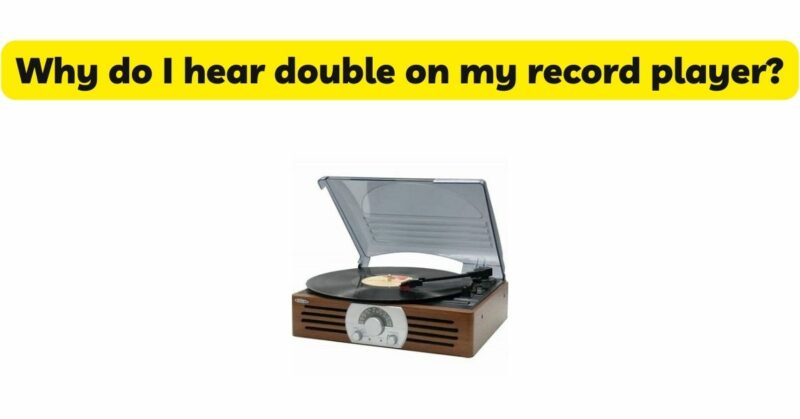Experiencing the phenomenon of hearing double sound on a record player can be perplexing and disrupt the intended audio playback. This effect, known as double tracking or ghosting, occurs when the audio from the record is heard twice with a slight delay, creating an echo-like perception. Several factors can contribute to double tracking on a record player, including groove damage, turntable setup, cartridge alignment, playback equipment, and environmental factors. In this article, we will explore the common causes of double tracking and provide insights on how to identify and potentially resolve this issue, ensuring a more accurate and enjoyable vinyl listening experience.
- Groove Damage: Damage to the vinyl record’s grooves, such as scratches, warping, or groove wear, can result in double tracking. As the stylus tracks the damaged grooves, it may reproduce the audio signal inaccurately, causing a delayed and repeated playback. Proper handling, cleaning, and maintenance of vinyl records can help prevent groove damage and minimize the occurrence of double tracking.
- Turntable Setup: The setup of the turntable components plays a significant role in the accuracy of audio playback. A misaligned tonearm or an improperly calibrated tracking force can contribute to double tracking. When the stylus fails to maintain consistent contact with the grooves, it can result in delayed playback and the perception of hearing the audio twice. Ensuring proper alignment and calibration of the tonearm, including proper tracking force and anti-skate settings, can help reduce double tracking.
- Cartridge Alignment: The alignment of the cartridge is crucial for accurate audio reproduction on a record player. A misaligned cartridge can cause the stylus to track the grooves at an incorrect angle, leading to double tracking. Checking and adjusting the cartridge alignment using alignment tools or seeking professional assistance can help improve tracking accuracy and minimize the occurrence of double tracking.
- Tracking Force: Inadequate or excessive tracking force applied by the stylus can contribute to double tracking. Insufficient tracking force may result in the stylus not fully engaging with the grooves, causing the audio signal to be partially reproduced and creating a delayed effect. Conversely, excessive tracking force can cause the stylus to dig too deep into the grooves, resulting in distortion and potential groove damage. Adjusting the tracking force to the recommended range specified by the cartridge manufacturer can help mitigate double tracking issues.
- Anti-Skate Adjustment: Improper anti-skate adjustment can lead to double tracking. The anti-skate mechanism counteracts the force pulling the tonearm towards the center of the record, ensuring balanced tracking across the groove. If the anti-skate is set incorrectly, the stylus may exert uneven pressure on the grooves, causing audio delays and the perception of double tracking. Calibrating the anti-skate to match the cartridge’s specifications can help maintain accurate tracking and reduce double tracking effects.
- Playback Equipment: The quality and condition of the playback equipment, including the turntable, phono preamp, amplifier, and speakers, can influence the occurrence of double tracking. Low-quality components or inadequate calibration can introduce inaccuracies in the audio playback, resulting in double tracking. Ensuring high-quality playback equipment and proper setup, as well as regular maintenance and calibration, can help minimize the impact of playback equipment on double tracking.
- Environmental Factors: Environmental conditions, such as temperature and humidity fluctuations, can also affect the occurrence of double tracking on a record player. High humidity levels can cause the record to absorb moisture and expand, potentially leading to groove distortion and double tracking. Similarly, low humidity levels can cause the record to shrink, affecting groove dimensions and audio playback. Maintaining stable and suitable environmental conditions, including moderate temperature and humidity levels, can help minimize these effects.
Conclusion: Experiencing double tracking on a record player can be a perplexing issue, but understanding the potential causes can help diagnose and potentially resolve the problem. Groove damage, turntable setup, cartridge alignment, tracking force, anti-skate adjustment, playback equipment, and environmental factors all contribute to the occurrence of double tracking. By inspecting and addressing these factors, such as properly handling and maintaining vinyl records, ensuring correct turntable setup, aligning the cartridge, adjusting tracking force and anti-skate, using high-quality playback equipment, and maintaining stable environmental conditions, you can improve audio accuracy and reduce the occurrence of double tracking. Experimenting with adjustments and seeking professional assistance when needed can help optimize your vinyl listening experience, ensuring faithful and enjoyable sound reproduction without the interference of double tracking effects.

